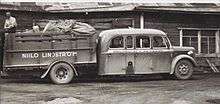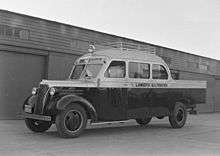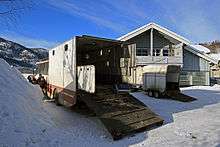Bruck (vehicle)










A bruck (blended from the words bus and truck) is a type of bus or coach built to combine goods and passenger transport where it is most profitable or most convenient compared to separate vehicles. The word bruck was used in North America. In Australia they were known as passenger-freighters. In Europe they are known as Kombinationsbus (German), seka-auto (Finnish), kombibuss (Norwegian) and godsbuss (Swedish), with even the nickname skvader. They have for practical reasons mostly been built on front- or mid-engined chassis. In North America and Australia this type of bus was introduced in the late 1940s as a replacement for unprofitable railway lines, while in Europe they have been around since the first buses.
Concept
A bus of this type is different from an ordinary bus, in that it has a separate cargo compartment that can be either closed or open air, and is by specification built for carrying goods in route traffic.
When the first automobiles were put into route traffic in rural areas, in many places they often took both passengers and cargo, including the mail. Many routes evolved into separate routes and vehicles for every purpose, but some stayed like this multi-purpose route, and a very few are still operating this way. As buses started to be built on truck chassis and later on purpose-built bus chassis, this type of routes needed a vehicle with the characteristics of a bruck. The first ones had open air cargo compartments for easy loading and unloading. Later some of them got canvas roof, some got wooden cargo boxes, and again some got the cargo compartment integrated into the bus body. As demands for cargo and passenter transport varied, some buses would have only a small cargo compartment, while others were more or less built as a crew-cab truck offering only a few passenger seats. From the early 1980s, cantilever tail lifts have become standard equipment on brucks, making loading and unloading a one-man operation. From the 1990s the cargo compartments have gradually become more boxy and taller than the rest of the bus for maximum capasity.
In general, most brucks have been front- or mid-engined to make best possible use of the cargo space in the rear end, and to make loading height as low as possible, in addition to a better weight distribution. In the Nordic countries front-engined chassis from Volvo and Scania were the most common, while many were built on Mercedes-Benz and DAF chassis too. When the front-engined chassis models disappeared from the European market in the early 1980s, mid-engined chassis from Volvo and DAF became the usual choice. A few were also built on rear-engined chassis from Scania, including some 4.2 metres tall doubledeckers in Sweden being bodied by Helmark Carosseri and Van Hool. DAF stopped making mid-engined chassis in the mid 1990s, so from then on brucks were almost exclusively built on Volvo chassis. With bus manufacturers taking over manufacturing of both chassis and body, the Volvo 9700 became the most common bruck model in the 2000s. Since Volvo also stopped making mid-engined chassis in late 2009, there have been far less brucks built than before. Only around 40 rear-engined brucks have been delivered to Sweden since then. As of March 2015, the last known brucks were delivered to Swedish operator Bergvalls Busstrafik in June 2014.
Reuse
Brucks are often quite popular on the second hand market, as their unique construction is handy for many different uses. In unconverted form, they can be used by charitable organization, as band buses, for touring theatre troops, or any group of people needing space for heavy and voluminous luggage. In converted form they are popular for motorsports, where one can use it as a mobile garage. They are also popular to convert to mobile homes, with enough luggage space for most people. They can also be converted to horse transport.
History
North America
Canada
The first brucks in North America were introduced in Canada by Western Flyer Coach in 1943.[1] This is also where the word bruck comes from. The company built both new brucks, and some were rebuilt from other buses, for Canadian Coachways,[2] who operated a number of these in the far north. They had a storage compartment accessible from the outside by a rear door, replacing the last rows of seats.
United States
In the United States, the brucks were introduced in 1951, when Kenworth built a tri-axle one for Northern Pacific Railroad, which had a front part for 17 passengers and a taller, 18 ft long cargo compartment and a 136 hp Hall-Scott engine.[3] Brucks were also available from Crown Coach, both as a 40 ft tri-axle carrying 20 passengers and with a 20 ft cargo compartment, or as a shorter 35 ft two-axle with 12 seats.[4]
Kenworth also delivered a batch of twelve tri-axle brucks to Great Northern Railway in Montana, where the front half was based on the Kenworth Model T-126 SchoolCoach body, while the second half was custom built.[5] They were fitted with a Hall-Scott under-floor "pancake" engine. One of these, that had been doing the local route from Kalispell to Whitefish and Columbia Falls between 1951 and 1971, have been preserved and is exhibited at the Whitefish Depot.[6][7]
Australia
In Australia they were known as passenger-freighters, and were introduced by Western Australian Government Railway (WAGR) in 1949, as a substitute to railway lines that had been closed. The first ones were built on Foden PVSC6 chassis with Gardner six-cylinder diesel engines.[8] They were green and cream in livery. Later they were built on rear-engined Hino RC320P chassis.[9]
Germany
In 1907, Karl Kässbohrer Fahrzeugwerke in Ulm built the first "Kombinationsbus". It had a wooden bodywork built on a Saurer truck chassis. Unlike other types of brucks, it had sideways-mounted folding seats so that the same space could be used for either cargo or passengers, and probably a combination too. Kässbohrer received a patent for this in 1910. It could accommodate 18 seated and ten standing passengers. It was used by a guest house for carrying beer kegs and also passengers.[10]
Since 2011, a cargo service by bus is offered in the Uckermark district, named kombiBUS. The service is however operated with conventional buses with underfloor luggage compartments and with trailers, so they have technically little in common with actual brucks.[11]
Nordic countries
In Finland, Norway and Sweden, brucks were quite common in the rural parts at the beginning of the 20th century. They were a good option not only where building a railway was not economically feasible, but also where the railwaybuilders had yet to arrive or where the landscape didn't allow for any railway line. For many years the transport of milk churns between farms and dairies was one of the major uses, but as milk tank trucks became common, this was no longer needed. The manual loading and unloading of milk churns was one of the main reasons for an open air compartment, and when this was not a factor anymore, brucks started to become more like the modern versions.
Finland
Today only one Finnish bus operator, the Rovaniemi-based Gold Line (subsidiary of Koiviston Auto), use modern type brucks with tail lift in route traffic. However some other operators also use buses and coaches where the rearmost metre or two is a walk-in cargo compartment with shelves. This compartment can be entered by a large door either on the door side or from the rear side.
Norway
In Norway, brucks are known as "kombibuss", or alternatively "kombinertbuss". With the exception of highly populated areas around Oslo, including areas where railway lines had been built in the late 19th century, brucks could be found in most of the country up to the 1980s, when standardised buses started to become more common, and the costly brucks were considered ineffective.
Norway's national touring theatre, Riksteatret, has for many years used brucks when touring the country, and for a long time it was Førde-based operator Firda Billag who operated the buses. However, from 1 January 2009 they have been operated by Nordreisa/Tromsø-based coach operator Bussring. Bussring bought one brucks second hand and ordered four new bruck coaches for the assignment. Contrary to all other brucks, these four that they ordered were never intended for use in route traffic, yet they are built to the same specifications. In 2014 they also bought one second hand from Firda Billag.
Firda Billag used to be one of the major bruck operators in Norway with over a dozen brucks in service, but in 2010/2011 they decided to sell the brucks and instead buy mini- and midibuses for the passenger traffic and trucks for the cargo. The passenger and cargo operations were also split into separate subsidiaries.
As of May 2015, brucks can mostly be found in the far north and along the west coast. In addition, two operators in Telemark operate brucks; Drangedal Bilruter operate one bruck between Tørdal and Drangedal Station, while Telemark Bilruter operate three bruck lines with a total of five bruck. The three lines are Åmot-Haukeli, Fyresdal-Vrådal-Seljord and Vrådal-Arendal.
Sweden
In the 1950s and '60s, the brucks in Sweden received the nickname skvader, because of their unlikely appearance as two widely different things put together as one, just as the origin of the word "skvader". In more recent years the brucks in Sweden are known exclusively by the word "godsbuss".
The largest population of brucks in the world has most likely always been and still is in Sweden, where they are still used on many long distance routes in the northern parts of the country. Sweden has also seen some special bruck construction. The largest are the nearly 15 metres long and 4.2 metres tall double-decker brucks that have been bodied by Helmark Carosseri and Van Hool. Earlier Van Hool have also bodied some quad-axle articulated brucks, where the passenger compartment and the cargo compartment were separated by the articulation joint. Some of these were later exported to Russia.[12]
Sending of packets and goods with brucks in Sweden is organised through the brand Bussgods, where both private customers and business customers can send different types of letters and packets or larger types of cargo by bus throughout the entire country. This includes both routes run with brucks and routes run with conventional buses and coaches or with trucks. The Bussgods logo is visible on the majority of Swedish brucks in operation today.[13]
References
- ↑ Illustrated History - 1943 New Flyer (Visited 1 March 2015)
- ↑ Archives Photographs Search Results - Canadian Coachways B151: Western Flyer "Bruck" (bus-truck), Edmonton, Alberta. Archived March 4, 2016, at the Wayback Machine. Glenbow Museum (Visited 1 March 2015)
- ↑ Buses (trucks) KENWORTH Vancouver B.C. U.S.A Myn Transport Blog 30 April 2014
- ↑ Crown Coach Coachbuilt 2004 (Visited 1 March 2015)
- ↑ Pacific Photos GilligsCoaches.net (Archived 23 July 2011)
- ↑ Historic Great Northern bus-truck restoration now ready for the road The Daily Inter Lake (via GilligsCoaches.net) 27 October 2005
- ↑ Great Northern's "Budd" McDonald, R.D. (Oil-Electric) 12 August 2009
- ↑ Foden PVSC6 Perthbus.info
- ↑ Hino RC320P Perthbus.info
- ↑ Translated from German Wikipedia (Visited 6 May 2015)
- ↑ kombiBUS.de (Visited 7 May 2015)
- ↑ Rostov region, # Х 282 РМ 161 — Van Hool T8 Alizée 360NL Gods Fotobus (Visited 7 May 2015)
- ↑ Bussgods Sverige (Visited 7 May 2015)
External links
 Media related to Brucks at Wikimedia Commons
Media related to Brucks at Wikimedia Commons